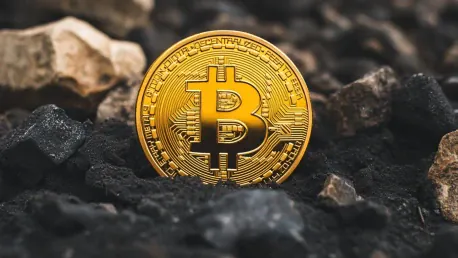Bitcoin mining forms the cornerstone of the Bitcoin network, sustaining the very backbone of this remarkable decentralized ecosystem. As we dive into the mechanics of Bitcoin mining, we explore the steady and predictable production rates that illustrate how approximately 450 new Bitcoins emerge daily. This regularity is pivotal, not just for daily operations but also for understanding the broader implications across weekly, monthly, and annual timelines. Bitcoin’s embedded halving mechanism, which periodically cuts mining rewards by half, is another focal point, ensuring Bitcoin’s long-term scarcity and reinforcing its decentralized nature.
Daily Bitcoin Mining Output
Bitcoin mining is an intricate yet consistently regulated process, producing around 450 new Bitcoins each day. This substantial predictability stems from Bitcoin’s protocol, which mandates that a block is created approximately every 10 minutes. At present, each block yields miners a reward of 3.125 BTC, cumulatively contributing to the daily output of 450 BTC. This dependable process bolsters the stability and fosters trust within the Bitcoin network.
It’s essential to understand that this daily output isn’t arbitrary. Instead, it’s a meticulously calculated figure based on the block creation rate set by Bitcoin’s underlying protocol. This consistency guarantees a steady growth rate in the Bitcoin supply, which plays a crucial role in its perceived scarcity and mounting value. The predictability of daily output serves as a cornerstone for evaluating Bitcoin’s production over extended periods, providing valuable context in assessing the cryptocurrency’s market dynamics.
Weekly, Monthly, and Annual Bitcoin Production
By extending the consistent daily mining output to weekly, monthly, and annual scopes, valuable insights reveal the broader impacts of Bitcoin mining. Given the daily creation rate of 450 BTC, weekly production amounts to approximately 3,150 Bitcoins. This aggregate highlights significant additions to the Bitcoin supply every week, influencing broader market trends and dynamics.
Considering a more extended timeline, monthly production reaches around 13,500 BTC. This figure is crucial for both investors and enthusiasts, offering a clearer perspective on the incremental supply growth over a month. Expanding further, annual production culminates in around 164,250 BTC, emphasizing the long-term influence of sustained Bitcoin mining activities on overall supply and market behavior. Such detailed insights affirm the critical role of mining output in shaping Bitcoin’s economic landscape.
The Bitcoin Halving Mechanism
Central to Bitcoin’s durable design is the halving event, an integral protocol element that occurs roughly every four years or after every 210,000 blocks. This event precisely halves the block reward given to miners, thereby controlling Bitcoin’s issuance rate. The halving mechanism is instrumental in governing the sustainable scarcity that underpins Bitcoin’s decentralization and value proposition.
The latest halving, which took place in April 2024, reduced the mining reward from 6.25 BTC to 3.125 BTC per block. This reduction notably impacts the daily mining output, now fixed at around 450 BTC. Looking ahead, the next halving in 2028 will further decrease the block reward to 1.5625 BTC, cutting daily mining output to roughly 225 BTC. This incremental reduction in supply is a core principle in Bitcoin’s architecture, ensuring long-term scarcity and sustained value growth over time.
Historical Context and Future Projections
Reflecting on Bitcoin’s historical mining context unveils the drastic evolution over the past decade. Originally, miners received 50 BTC per block, resulting in incredibly high annual outputs. Comparatively, today’s scenario with a 3.125 BTC block reward showcases significantly reduced annual production. Presently, just under 20 million Bitcoins are in circulation, accounting for over 95% of the total cap of 21 million BTC. With fewer than 1.1 million Bitcoins left to be mined, the implications of this continually diminishing supply become more vivid.
Projecting into the future, the ultimate milestone looms in the year 2140, the estimated timeline for mining the last Bitcoin. Post-21 million BTC, miners will pivot to earning solely via transaction fees, maintaining network functionality and security. This forward-looking scenario underscores Bitcoin’s sustainability, reinforcing its deflationary nature and highlighting the intricate balance between supply control and decentralized ethos.
The Role of Mining Setups
Varying mining setups significantly influence the efficiency and profitability of Bitcoin mining operations. Industrial-grade mining setups, equipped with advanced rigs, can mine fractions of a Bitcoin daily due to their concentrated computing power and energy allocations. Conversely, home miners encounter more challenges, often necessitating participation in mining pools to enhance their chances of success. Mining pools aggregate resources, increasing the probability of earning rewards and offsetting individual limitations.
For an individual miner aiming to produce one Bitcoin a day, the requirements are formidable, necessitating around 6,837 Antminer S21 miners. This considerable setup involves significant associated costs, excluding electricity and operational expenses. These practical insights underscore the challenges and highlight the vital role of efficient, powerful mining setups in achieving profitability and sustainability in the context of Bitcoin mining.
Bitcoin as Digital Gold
Bitcoin mining is central to the Bitcoin network, maintaining the foundation of this decentralized system. When examining the mechanics of Bitcoin mining, we see a consistent and predictable production rate resulting in about 450 new Bitcoins being created daily. This regularity is essential not only for daily operations but also for understanding its effects on weekly, monthly, and annual scales.
A key aspect of this process is Bitcoin’s halving mechanism, which reduces mining rewards by half approximately every four years. This built-in feature ensures Bitcoin’s long-term scarcity, making it a deflationary asset. The halving mechanism underscores Bitcoin’s rarity, as fewer new Bitcoins enter circulation over time, contributing to its decentralized nature. The entire mining process, from the day-to-day creation of new Bitcoins to the strategic reduction in rewards, showcases the intricate and well-thought-out design of Bitcoin, highlighting its commitment to a decentralized financial future.









